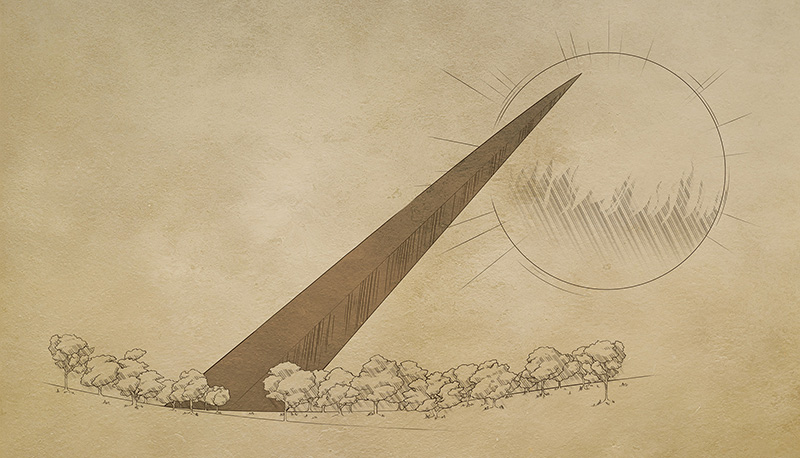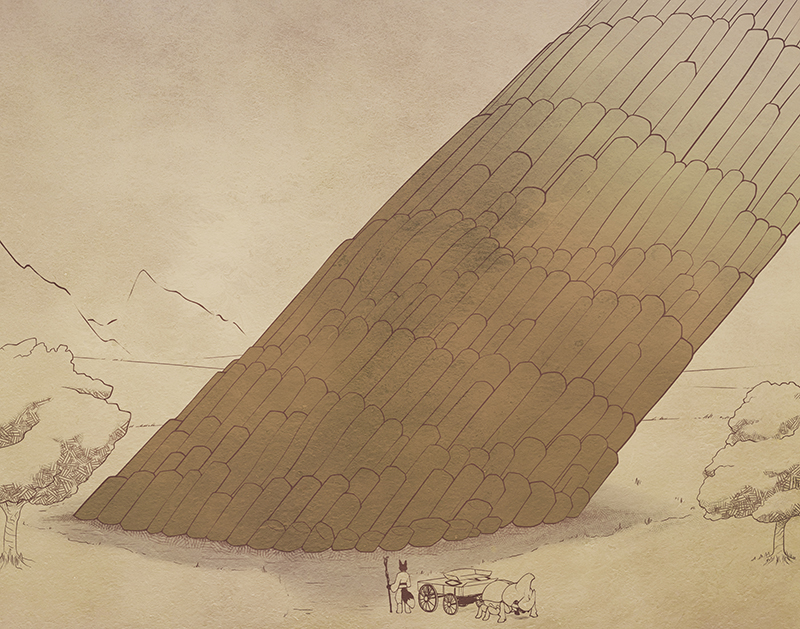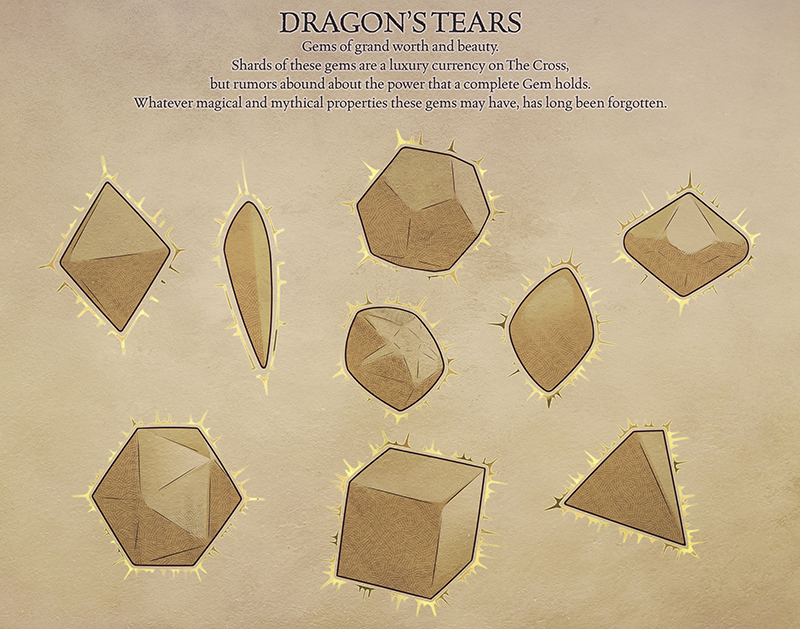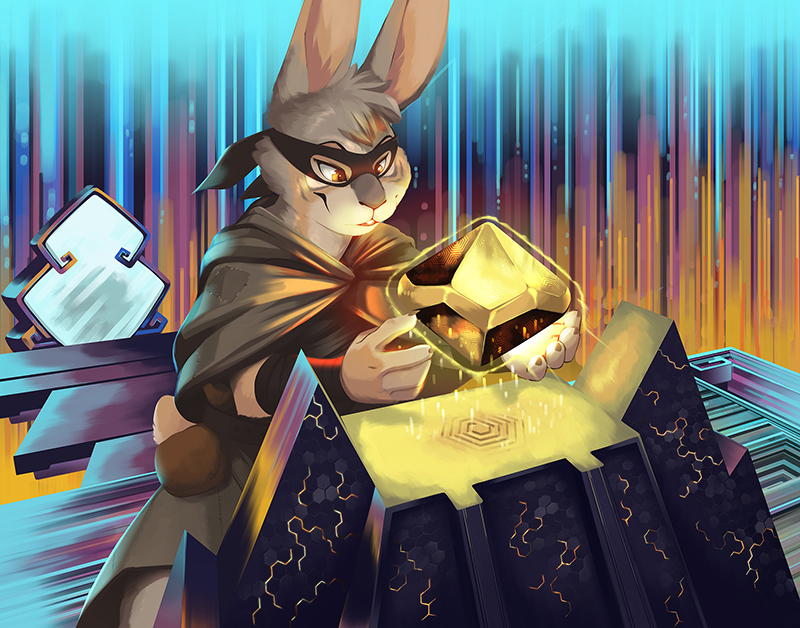World Features
Navigation
Dragon’s Teeth/Spires
Dragon’s Teeth are gigantic, black spikes that pierce the sky with forgotten purpose. They all angle to point directly at Coeurasa with their tapered tips, sides coming together at the top in an impossibly sharp point. Composed of a dark, black stone across their surface, the Teeth can be seen against any daytime horizon, but from how far depends on just how tall they are. The height of the Teeth can vary from location to location, some being as short as a hundred feet off the ground, contrasted against the staggering lofts of spires that reach thousands of feet above the surface. Many of the inhabitants of The Cross refer to these structures as Spires, a vernacular made for convenience. Legends abound that the Dragon’s Teeth hoard lost treasures, but those foolhardy enough to plunder them are cursed unto their death, perhaps even cursing the entire region around a Spire. There are rumors that some Spires even contain the coveted and extremely valuable crystals known as Dragon’s Tears.
These towering structures have dotted the landscape of The Cross for all of history. Even the most ancient stories consider them an immutable fixture of the landscape. Travelers from afar report likewise in familiar regions, giving rise to the idea that they cover the whole world. There is debate what the Spires do and what they look like amongst different regions of The Cross, as some Spires have a beautiful golden glimmer hidden amongst the black stone. Some are entirely covered in runaway plant growth. Some are thick and some are thin, and the only real consensus amongst people is that they are mysterious, and often, ominous.
External appearance
Closer inspection of the Dragon’s Teeth reveals a patterned surface made of countless thin columns, smooth to the touch, faceted together to form the walls of the structure. The long rectangular sections are smooth to the touch. Each of these columns features a faceted spiral on its end, as if each column was rolled up from some great sheet by unknown forces.
The external appearance of a Dragon’s Tooth hints at its internal condition. On active spires, the long rectangular sections of the surface columns feature a repeating pattern that have a dim gold glow. The light emanating from the spires do attract Nocturnal Alas, which can cover up and hide the glow of the spire, from a distance masking it as inactive or destroyed.
Dormant shrines and shrines missing their Tear do not feature an emanating glow. Dormant shrines are maintained by lesser Guardians, preserving the appearance of the exterior. Shrines missing their Tear are unmanaged by Guardians and are generally overgrown with flora. Despite the years of growth, plants tend to remain on the surface, with few known instances of roots causing internal structural damage.
On taller shrines, additional structures surround the area; they differ from shrine to shrine but are usually fields of smaller spikes resembling Dragon’s Teeth, a large forest of stone thorns, or a stone grid pattern on the ground covered in undecipherable glyphs. Closer to these taller shrines are tall slabs of stone covered in more undecipherable glyphs and a few recognizable pictograms of Coeurasa, Fate, and Dragon’s Teeth.
Internal appearance
Beyond the dark tones of the outer walls of a spire the structure proves to be a hollow vessel gleaming with multicolored radiance, warping light and gravity. Much like the coloration and multi-layered step pattern of a bismuth crystal, the inner walls brim with an otherworldly power that is present in more than one plane of existence at once. At times faint images can be made out in the walls that are often unseen by guests of a spire, giving the feeling of an observing presence. Crystalline structures float by the same enigmatic power that runs through the Dragon’s Tooth, housing the spire guardians. Much to the Order’s frustration, magic has not been determined to be the cause of the spire’s oddities.
Internal maps
Every Dragon’s Tooth will be different from the last, from their shape to their contents. The most common traits for the content of a spire are structures levitated by some enigmatic force, composed of uneven terrain, unconnected and far removed from the walls of the spire itself.
The sections that make up this floating terrain are often separated by invisible walkways and drops in elevation. Mirror-like structures on the floating terrain act as doorways, transporting the visitor to another connected mirror. The location of a Dragon’s Tear is well protected by both active Guardians and the terrain itself. The terrain is modified by the Guardians to better protect the Tear. Spire guardians ascertain the nature of their invaders and the path to the Tear is shaped with that in mind. Commonly the intent is to dwindle the invaders’ resources and deplete their physical and mental health before the authority level guardians directly interfere.
Internal traps
The majority of traps in a dragon’s tooth take the form of psychological assaults. The mental conglomerate of the spire utilizes the traps to find weaknesses in the intruders’ mind that can be superimposed into their physical senses to trick, disable, control, and separate intruders to optimize the chances for the guardians to eliminate the threats. These defenses need not be static systems set in place for all time and can be created quickly. More rarely, traps are physical so long as they do not inhibit the capabilities of the guardians or damage the spire; some examples include crystal spikes formed from a surface which could be laced with mineral poisons or illusory trap doors that conceal floors and doorways.
The most common mental traps are emotion spikes which disable intruders with emotional pain. These traps are triggered by proximity, and both their area of effect and the immediacy of their reaction is variable. Light manipulation, spire dust, and sonic tones can be used to create illusions that produce sound or conceal both visual presence and scent. They often occur in an area, selecting targets in a strategic manner such as prioritizing those that are more susceptible first. Another common mental trap is the Aurora Mind Prison where auditory and optical receptors of the targets are overloaded, forcing them into a mental recess. The victim of a Mind Prison will perceive themselves alone within their consciousness, while in reality, their physical mind is taxed beyond its limits. This can amount to a sudden comatose state, loss of mental capacities, hemorrhages in the brain and eventual death.
Internal Monsters (Guardians)
A creative hand took much joy in the malleability of form and purpose for the guardians of each shrine. As such, they were created to be able to adapt to unexpected situations and challenges. In combat, the guardians become better at harming intruders with every moment that they focus on and observe them. The most common guardian formations are as follows:
The Spire Hounds
These beasts are made from living bubbles that cover an intruder with themselves. Once fully surrounded, a victim attacked by Spire Hounds will find themselves suddenly unable to breathe, shortly before the Hounds squeeze out what air they still possess in their lungs. Any attacks made against the Hound will also harm the victim.
The Constructs of Thought
These creatures are adaptively shaped from the crystal of the spire by the hive mind to best deal with intruders. They are formed with abilities that are based on the observations of the intruders. Their abilities are focused on working with the environment to the guardians’ advantage, such as being able to climb sheer surfaces to out maneuver a group or pull them off of stable ground.
The Umbral Wraiths
Spectral entities projected from the hive mind that wish to do extreme harm to the living and planar interlopers; they often drain away a person’s sense of self with their touch.
Sprites
Intelligent entities that exist on multiple planes and act as stewards that discern the intent of visitors. They appear three dimensional from one side and can alter their physical appearance in seconds. Sprites are highly resistant to magic, emanate auras that can warp the mind inducing extreme states of emotion or dulling emotions potentially to total complacency. They can also create pulses with various forms of elemental energy if pressed to defend themselves; these pulses do not harm Spire Guardians.
The Spire Golem
Perhaps the most well known entity in a spire, though not for their commonality but in their presence in every active spire. These crystalline Golems often tower over an ordinary person, are generally bipedal, have a vaguely humanoid appearance, and are capable of fine manipulation. They guide the actions of other guardians, seem to always possess more information than is comfortable about the world outside the spire and about intruders, particularly after they have been through some of the spire’s traps and creatures. Spire Golems usually hold off contact with intruders until the Tear is in danger, opting to observe, plan, and send tactical recommendations to other guardians. They themselves possess monstrous strength, resistance to magic, and interact with the machinations of the spire as if a living part of the structure; they also possess additional abilities developed from their experiences acting as stewards of their spires. Displaced Spire Golems seek out other active spires to take up residence, forming partnerships or conclaves with other Spire Golems.
Tech/Devices
The machinations of the Dragon’s teeth have long escaped the understanding of even the greatest scholars of the Order proper. So far, the Order has been able to only hypothesize that the spire’s functions are not accessible by any device or set of devices and requires some sort of alternative connection or input to produce an observable response.
The walls of a spire contain a concentrated network of egos and passing through exposes travelers to the danger of losing who they are from the foundations up. Attempts to enter through means other than a physical entrance often causes mental damage that some never recover from on their own. This effect is both a defense and a necessity for the functionality of the spire.
Strange things take place within a Dragon’s Tooth, ranging from invisible paths, to uneven gravity, or even the transmission of whole groups of people from one space to a completely different part of the spire. There have been tales of terrain moving on its own to form new paths presumably for varied defensive purposes. The guardians of a spire have a hive mind that imparts various levels of tasks and authority. Accessible information has only been rumored to be exchanged with the guardians residing in Bisemutum. No member of the Order has had definitive investigations on this matter.
Loot
Dragon’s Teeth traditionally contain a myriad of strange tools, crystal-based relics, unusual weapons, as well as objects whose creation process has been long lost to the world. For those that do enter the spires, locating the remains of other formerly aspiring adventurers and their gear is the most common sort of loot to be found. Guardians of the spire are proficient in the use of magical objects and equipment, and some even utilize the gear left behind by adventurers to enhance their natural abilities. Each spire that has suffered intrusion often creates a stockpile of goods that can be used to lure intruders into compromised positions or used directly against the intruders.
Activation Event
Upon the activation of a Spire, there is no obvious or immediate change in its appearance as seen from afar. Nearby, careful observers may note a sudden shifting of the barely exposed inner layers of stair-step crystals. Specific relays are connected and pathways are created to channel energy that is beyond current understanding. Some of the surface pillars adjoin while others separate for this occasion. The tiniest of dull hums can be heard as Guardians either suddenly become active or change their behavior to purge the Spire’s surface of all physical attachments. Most non-Spire entities in the immediate area around the activating Spire are also cleansed. The final occurrence in an activation sequence to an observer is the slow “filling” of the golden glow up the Spire’s form, indicating the Spire has started performing its mysterious duty.
Deactivation Event
In the event a Spire is deactivated, the first effect usually is that the golden glow of the Spire fades away over a very brief period. Depending on how the Spire is deactivated, the inner layers of the stair-step structure may separate to reverse any changes from activation and protect the relays from degradation; more often than not, however, the method of deactivation simply terminates the Spire’s ability to function properly and leaves the Spire in its activated form without any method to operate. Very few people in the world have ever observed or made the correlation that through some unknown means, whenever a Spire is deactivated another one elsewhere is immediately activated if it is able.
Dragon’s Tears
Precious, brilliant gems that refract light with intensity like no other mineral can. Smaller pieces, polished or not, are coveted as a luxury currency. These “Shards” are traded with a value given much greater than that of gold. Most pieces are shaped smaller than even a common copper piece, but larger fragments can be found in the most affluent heights of society. Fully intact Dragon’s Tears are smooth, brilliantly refracting gemstones, about the size of a cantaloupe. Such marvels were clearly shaped by masters of their craft, and yet neither tool markings nor natural blemishes have ever been found on a complete Dragon’s Tear. Certain sects of society deal in the trade, shattering, and refinement of these sources of beauty. Such business is highly secretive, but rumor has spread that a Tear can only be found unscathed in the depths of a Dragon’s Tooth. Some whispers even claim that a Dragon’s Tear glows with a golden and warm inner light, that emanates through the Tear’s majestic and unparalleled patterns.
Character: Lupin the Raven
Coeurasa
A familiar and unmoving resident of the sky as seen from The Cross, Coeurasa is the primary fixture of the celestial sphere aside from the sun. It is large enough to maybe even be considered a planetoid if it orbited the star instead of the planet. Its orbit makes it both tidally locked and fixed in a geosynchronous pattern. As such, the surface of Coeurasa seems unmoving on its own accord, and the moon always sits in the same place in the sky no matter the time of day or season. Coeurasa is as familiar and permanent in its part of the sky as any other landmark or ocean feature.
Each night Coeurasa slowly comes into view as daylight fades, appearing as a waxing half-moon at the moment of sundown. As the night progresses, Coeurasa’s phase shifts with it, changing from a half-moon to a full moon. The moment of full moon is the exact time between dusk and dawn, and as the moon passes this moment, it will begin to wane back into the opposite half-moon from the one it started as. As the sun rises, the half-moon Coeurasa will begin to fade from view, its silver light overtaken by the sun. Only special lenses and optics allow certain scholars to see the great moon during the day, observing a period where its light fades totally from existence as the brilliance of the sun directly behind it suppresses her beauty. Some cultures revere these phases and the moon itself as a guiding deity, the ever-present watcher in their lives.
Blink
Every year at the coming of Season of Earth, the impending fall solstice brings an end to the shortening of days and lengthening of nights, cooler weather, and the changing of the leaves; it also brings a marked change in the appearance of Coeurasa. At her zenith when she shines fullest and brightest , a massive curved shadow slowly starts to spread up Coeurasa’s surface from below, like a great closing eyelid. Starting about a month before the solstice, the shadow reaches further and further up Coeurasa’s full face each night until, just two days before the solstice, it completely overtakes the silver glow of the moon. When the silver fades, Coeurasa dully luminesces a great muted red color, akin to staring at torch light through a closed eye. For the few longest nights of the year, she looks this way during her zenith, engaged in her massive blink. The red is barely visible to only the most trained eyes when Coeurasa is not at zenith, the fledgling silver light growing at the same time it gets consumed by the Dragon’s Shadow. Festivals celebrating the end of the year, certain religious observations, and scholars fastidiously studying are all abound to mark the event. Then the shadow slowly recedes over another month, Coeurasa’s soft silver ambience at her zenith returning to her face and bathing the night world once again in a new year.
Fate
The smaller sister to Coeurasa, a second moon of the world, is known as Fate. She is far more coy than her primary sibling, and only appears to the Cross for brief moments in the night at the very edge of the southern sky. Stranger still is that the pattern is not consistent from night to night like Coeurasa’s. Fate’s appearance is not marked at any specific time of year or season, but appears for merely an hour or so in Fate’s Nights. She can show all the same phases as Coeurasa can, but only one on any given night. These phases appear to follow the same order as Coeurasa’s do, confirming their relationship to one another. The time of her appearance is never the same from night to night, with her first peek into the world happening just before dawn and slowly transitioning over a week and a half or so to vanish into the setting sun. Few residents of The Cross regularly get to observe this behavior. Coeurasa’s silvery glow is comforting to most people, but many find the orange-tinted Fate to be disturbing in its timing and appearance. This has led to many residents believing that the appearance of Fate at any given significant moment to be a sign of disaster or cursed portent. Others see her brief entrance into the world as a sign of good fortune and tidings to come, as the timing required can only be explained by turns of good luck.
The scholars of the Order of Arcane Sages have kept detailed records of her travels and have compiled a rudimentary foretelling of her appearances. Mathematics, they say, can predict Fate just as easily as the turning of the seasons. Their calculations are not perfect, and for many years have either ended up falling short or overshooting. The common person has no inkling of such predictions at all and find trying to predict her exact behavior is impossible. In extremely rare circumstances, detailed in progressively older and older tomes of the Great Library, Coeurasa can completely fill the area of the sky where Fate would be seen. The mages see it as a natural occurrence and think little of it, but documented history shows that the more superstitious members of society believed Coeurasa was shielding the world from Fate’s influence, averting great natural disasters or society’s end. One such scroll details the account of a mage seeing a massive, infinitely intricate arcane emblem upon the surface of Coeurasa during one such celestial apex, though they all dismiss it as the ravings of a madman.
Contact Us
If you have any additional questions or would like clarification, please feel free to contact us.



